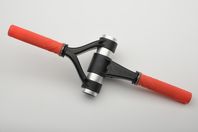Asia
EMEA

LANXESS Canada Contacts
Contact our Sites in Canada
Media Inquiries
General Inquiries
Please click here to e-mail LANXESS Canada with product inquiries and general requests.
Global Press Releases
2018-03-14
LANXESS improves the performance of its plastic metal hybrid technology
Hollow profiles instead of sheet metal
- Higher levels of stiffness and strength compared to hybrid solutions with sheet metal
- Designed for mass production
- Focus on structural components such as cross car beams
Plastic metal hybrid technology is an established method for manufacturing lightweight structural components developed by the specialty chemicals company LANXESS. This technology systematically combines the advantages of metal and plastic. It has been used for many years to manufacture automotive parts like front ends, pedal boxes and brake pedals. This hybrid technology includes glass fiber reinforced polyamide 6 for injection molding as well as a steel or aluminum sheet as metal component. LANXESS has now extended the use of its hybrid technology to metallic hollow profiles with round or rectangular cross sections. “Compared to sheet metal, hollow profiles show significantly higher dimensional stability as well as increased torsional strength and stiffness,” explains Lukas Schröer, project manager for lightweight structures in the High Performance Materials (HPM) business unit. “We believe that this new ‘Hollow Profile Hybrid Technology’ enables the manufacturing of components such as cross car beams, which up until now were not resilient enough using classic plastic metal hybrid technology.”
Simple and affordable manufacturing process
For its hollow profile hybrid technology, LANXESS developed an economical, one-step process that has to meet multiple challenges: “It needs to be possible to smoothly and fully automatically place the metal inserts into the injection molding tool. Due to their production process, these metal inserts exhibit dimensional tolerances, which can damage the tool. In case of undersized inserts leaks in the tool system may result,” explains Boris Koch, hybrid technology specialist in the HPM business unit’s technical application development. Additionally, in order to avoid the profile to collapse due to the high levels of melt pressure during the injection molding process, the metal insert has to be supported. Another challenge was creating a long-lasting, form fitting bond between the plastic and the metal in all directions. According to Koch: “The result of our development work is a process that is suitable for large scale production, only requires an investment in standard injection molds and machines, makes short cycle times just like standard injection molding possible, and is just as simple as the classic hybrid technology using metal sheets.”
A wide range of applications
In addition to cross car beams, this new hybrid technology offers significant potential for use with other structural components with high mechanical demands. “With respect to lightweight automotive components, we’re thinking about seat structures, front ends, tail gates, and mirror brackets in trucks. But we also see potential for this technology in the manufacture of furniture, ladders, and strollers,” says Schröer.
LANXESS offers customized polyamide compounds as injection molding materials for its hollow profile hybrid technology. “This includes particularly easy-flowing material varieties for complex ribbed structures and shapes as well as highly filled types of polyamide 6 that, thanks to their outstanding mechanical properties, take the structural performance of hybrid components to a higher level,” explains Koch.
Outlook: use of die-cast and extrusion molding inserts
LANXESS is currently working on expanding hybrid technology to simple and competitive die-cast or extrusion molding inserts. “Even hollow profile inserts made of fiber-reinforced composite can be used in the new hybrid technology,” says Koch. “This allows manufacturers to achieve further weight reductions in the mass production of structural components.”
Forward-Looking Statements
This company release contains certain forward-looking statements, including assumptions, opinions, expectations and views of the company or cited from third party sources. Various known and unknown risks, uncertainties and other factors could cause the actual results, financial position, development or performance of LANXESS AG to differ materially from the estimations expressed or implied herein. LANXESS AG does not guarantee that the assumptions underlying such forward-looking statements are free from errors nor does it accept any responsibility for the future accuracy of the opinions expressed in this presentation or the actual occurrence of the forecast developments. No representation or warranty (expressed or implied) is made as to, and no reliance should be placed on, any information, estimates, targets and opinions, contained herein, and no liability whatsoever is accepted as to any errors, omissions or misstatements contained herein, and accordingly, no representative of LANXESS AG or any of its affiliated companies or any of such person's officers, directors or employees accept any liability whatsoever arising directly or indirectly from the use of this document.
LANXESS is a leading specialty chemicals company with sales of EUR 7.7 billion in 2016 and about 19,200 employees in 25 countries. The company is currently represented at 74 production sites worldwide. The core business of LANXESS is the development, manufacturing and marketing of chemical intermediates, additives, specialty chemicals and plastics. Through ARLANXEO, the joint venture with Saudi Aramco, LANXESS is also a leading supplier of synthetic rubber. LANXESS is listed in the leading sustainability indices Dow Jones Sustainability Index (DJSI World and Europe) and FTSE4Good.
- Gallery




